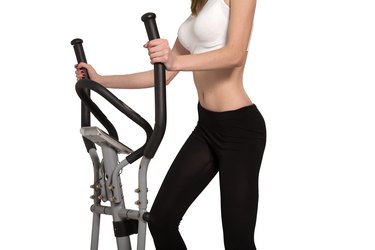
Elliptical machines are some of the most popular cardio machines found in a gym. A variety of ellipticals exist on the market, including some that incorporate an arm workout along with the typical striding movement of the legs. These ellipticals have movable arms, rather than the stationary hand grips found on other elliptical machines. You must use an elliptical machine properly to avoid foot pain caused by the repetitive stepping motion.
Step 1
Wear running shoes that properly support your foot. According to podiatrist Patrick J. Nunan, excessive pronation, or being flat-footed, can lead to pain in the heel. If your feet pronate, look for an anti-pronation running shoe to help adjust the foot into a position that will decrease your risk for heel pain when walking or using the elliptical trainer.
Video of the Day
Step 2
Stretch the bottom of your feet before working out on the elliptical trainer. Sit barefoot in a chair and place one foot in your lap. Interlock the fingers of one hand with the toes of the opposite foot. Use your fingers to flex your toes toward the top of your foot, making sure to feel a stretch along the bottom of your foot. Repeat on the other foot.
Step 3
Plant your feet flat on the pedals of the elliptical machine. Placing the weight on your toes, or constantly using your toes to push off the elliptical with each stride will cause injury to the connective tissue on the bottom of your foot. Fitness professional Rick Kaselj says exaggerating or prolonging this propulsion phase of the step can lead to microtrauma or degeneration of the plantar fascia of the foot. The plantar fascia is the tissue that connects the fore foot to the hind foot.
Tip
Place a tennis ball or golf ball on the floor and use the bottom of your bare foot to roll the ball back and forth. Press down on the ball to apply more pressure to the sore parts of the foot to massage the plantar fascia.
Warning
Avoid excessive pressure on the heel during everyday activities. Constant standing and excessive jumping can aggravate the plantar fascia, making it more prone to fasciitis.
Video of the Day
Is this an emergency? If you are experiencing serious medical symptoms, please see the National Library of Medicine’s list of signs you need emergency medical attention or call 911.